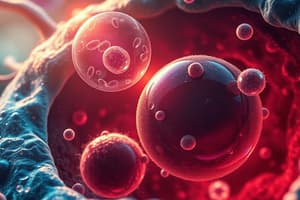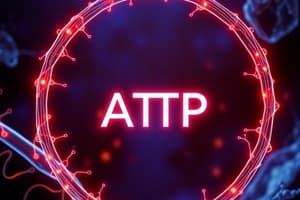Podcast
Questions and Answers
What is a key function of mitochondria within a cell?
What is a key function of mitochondria within a cell?
- Break down organic molecules into carbon dioxide (correct)
- Transport nutrients across the cell membrane
- Store excess water
- Synthesize proteins
What is meant by the term 'semi-permeable' in context of cell membranes?
What is meant by the term 'semi-permeable' in context of cell membranes?
- Permits any substances to flow freely across the membrane
- Blocks all molecules from entering or exiting the cell
- Only allows small and non-polar molecules to enter and exit (correct)
- Allows large polar molecules to pass through easily
What characteristic of the inner membrane of mitochondria is notable?
What characteristic of the inner membrane of mitochondria is notable?
- It contains large openings to allow passage of large molecules.
- It has a single layer.
- It is impermeable to all types of molecules.
- It is infolded into structures known as cristae. (correct)
Which of the following statements about osmosis is correct?
Which of the following statements about osmosis is correct?
What role do vacuoles play in plant cells?
What role do vacuoles play in plant cells?
Which characteristic of life describes the ability of an organism to maintain a stable internal environment?
Which characteristic of life describes the ability of an organism to maintain a stable internal environment?
What type of organism generates its own energy using sunlight or chemical gradients?
What type of organism generates its own energy using sunlight or chemical gradients?
Which of the following describes the Last Universal Common Ancestor (LUCA)?
Which of the following describes the Last Universal Common Ancestor (LUCA)?
Which process is an example of an autotrophic ability?
Which process is an example of an autotrophic ability?
What substance is essential for the bonding of life-form elements according to the basic necessities of life?
What substance is essential for the bonding of life-form elements according to the basic necessities of life?
What is the primary limiting factor that made some environments unsuitable for LUCA?
What is the primary limiting factor that made some environments unsuitable for LUCA?
Which of the following components is NOT found in the water ejected from black smokers?
Which of the following components is NOT found in the water ejected from black smokers?
Which term describes a self-sustaining system capable of Darwinian evolution?
Which term describes a self-sustaining system capable of Darwinian evolution?
What type of environment do white smokers provide that is conducive to potential life forms?
What type of environment do white smokers provide that is conducive to potential life forms?
Who was the first to observe living cells and what did he call them?
Who was the first to observe living cells and what did he call them?
What is NOT a tenet of modern cell theory?
What is NOT a tenet of modern cell theory?
What microscopy technique offers the highest magnification capacity?
What microscopy technique offers the highest magnification capacity?
Which scientist's work laid the foundation for modern cell theory by asserting that cells comprise both plants and animals?
Which scientist's work laid the foundation for modern cell theory by asserting that cells comprise both plants and animals?
What feature do phospholipids naturally form that is essential for cellular membranes?
What feature do phospholipids naturally form that is essential for cellular membranes?
Which statement describes a property of light microscopy?
Which statement describes a property of light microscopy?
What did Rudolf Virchow contribute to cell theory in 1858?
What did Rudolf Virchow contribute to cell theory in 1858?
What is the main function of scanning electron microscopy (SEM)?
What is the main function of scanning electron microscopy (SEM)?
Which component is NOT part of the basic requirements for a cell?
Which component is NOT part of the basic requirements for a cell?
What feature distinguishes eukaryotic cells from prokaryotic cells?
What feature distinguishes eukaryotic cells from prokaryotic cells?
What is the role of proteins in the cell membrane?
What is the role of proteins in the cell membrane?
Which of the following is characteristic of prokaryotic cells?
Which of the following is characteristic of prokaryotic cells?
What is the primary function of the Golgi apparatus in eukaryotic cells?
What is the primary function of the Golgi apparatus in eukaryotic cells?
Which statement about the phospholipid bilayer of the cell membrane is true?
Which statement about the phospholipid bilayer of the cell membrane is true?
What is the main characteristic of the cytoplasm in cells?
What is the main characteristic of the cytoplasm in cells?
Flashcards are hidden until you start studying
Study Notes
Mitochondria and Chloroplasts
- Originate through symbiogenesis, indicating a mutual relationship between prokaryotic cells and eukaryotic hosts.
- Mitochondria have two membranes, with the inner membrane featuring structures called cristae.
- Function in breaking down organic molecules into carbon dioxide and water through oxidative respiration.
Mitochondria Theory
- Proposed that mitochondria evolved from prokaryotes living symbiotically within larger eukaryotic cells.
Cell Membrane Chemistry
- Cell membranes are semi-permeable, allowing small, non-polar molecules to pass while larger, polar molecules are restricted.
- Osmosis occurs as water moves from areas of high water concentration to areas of low concentration, or towards areas with higher solute concentrations.
Cell Wall
- Present in plants and fungi; limits cell expansion due to osmosis.
- Cells with no walls expel excess water using vacuoles, which store nutrients, ions, and wastes, also contributing to turgidity.
Characteristics of Life
- All living organisms respond to internal and external stimuli.
- Growth, development, reproduction, and maintenance of homeostasis are essential life functions.
- Complex chemistry encompasses metabolism, including processes like photosynthesis and glucose digestion for ATP production.
- Organization is based on cell structures.
- Evolution through natural selection leads to changes in gene frequencies.
Origin of Life Essentials
- Key elements for life: hydrogen, phosphate, nitrogen, carbon dioxide, methane, ammonia.
- Water acts as a solvent for these elements, while energy sources are vital for life formation.
Classifications of Organisms
- Autotrophs generate energy via sunlight or chemical gradients, while heterotrophs consume organic substances for energy.
- Locations for autotrophs include land and hydrothermal vents, which provided a stable habitat early in Earth's history.
Hydrothermal Vents
- Represent fissures in the Earth's crust, ejecting mineral-laden hot water.
- Black smokers release acidic water rich in sulfur and metals but are too hot for early life forms.
- White smokers include less acidic, alkali emissions and may have been more suitable for the earliest life.
LUCA - Last Universal Common Ancestor
- Represents the earliest known life form, characterized by genes common to all three life domains: archaea, bacteria, eukarya.
- Lived in high-temperature, oxygen-free environments like hydrothermal vents.
Classification of Hydrothermal Vents
- Black smokers: Release acidic, mineral-rich water; too hot for LUCA.
- White smokers: Located near mid-Atlantic Ridge, possibly offered a more hospitable environment.
Biological Cell Types and Cell Theory History
- Cell theory posits that all living things consist of cells, which are the basic units of life, arising from pre-existing cells.
- Robert Hooke named cells in 1665, observing them in dead plant tissue.
- Antonie van Leeuwenhoek identified living cells.
- Schleiden and Schwann established that plants and animals consist of cells.
- Virchow stated all cells arise from existing cells.
Modern Cell Theory
- Describes that all living organisms are composed of cells and that new cells arise from pre-existing ones.
Origin of Cells
- Initially formed from phospholipid bilayers and self-replicating RNA molecules or proteins developing complex machinery over time.
Kinds of Microscopy
- Light microscopy: Utilizes visible light for magnifying specimens up to 1000 times.
- Transmission electron microscopy (TEM): Offers detailed views of internal cell structures with magnification up to 10 million times.
- Scanning electron microscopy (SEM): Provides surface views with magnification up to 1 million times, revealing intricate details like atoms.
Basic Requirements for Cells
- Must contain a protein-synthesizing apparatus involving DNA, RNA, and proteins.
- Require space for chemical reactions, typically provided by cytoplasm.
- A membrane is necessary to separate cells from their environments.
Cell Membrane Structure
- Composed of a double layer of phospholipids with hydrophobic and hydrophilic regions.
- Embedded with proteins, carbohydrates, cholesterol, and in plants, chlorophyll.
- Proteins facilitate the transport of large hydrophilic molecules and ions across the membrane.
Classification of Cells
- Eukaryotic cells: Have DNA within a membrane-bound nucleus, are larger, and contain various organelles (mitochondria, Golgi apparatus).
- Prokaryotic cells: Lack a membrane-bound nucleus, possess circular DNA, and are typically smaller and simpler (include bacteria and archaea).
Parts of the Eukaryotic Cell
- Nucleus: Houses DNA and proteins.
- Nucleoli: Found in nucleoplasm, site for ribosomal RNA assembly.
- Ribosomes: Located in cytoplasm, crucial for protein synthesis.
- Endoplasmic reticulum: Synthesizes, packages, and transports proteins.
- Golgi apparatus: Directs proteins and substances to necessary cell locations.
Studying That Suits You
Use AI to generate personalized quizzes and flashcards to suit your learning preferences.




